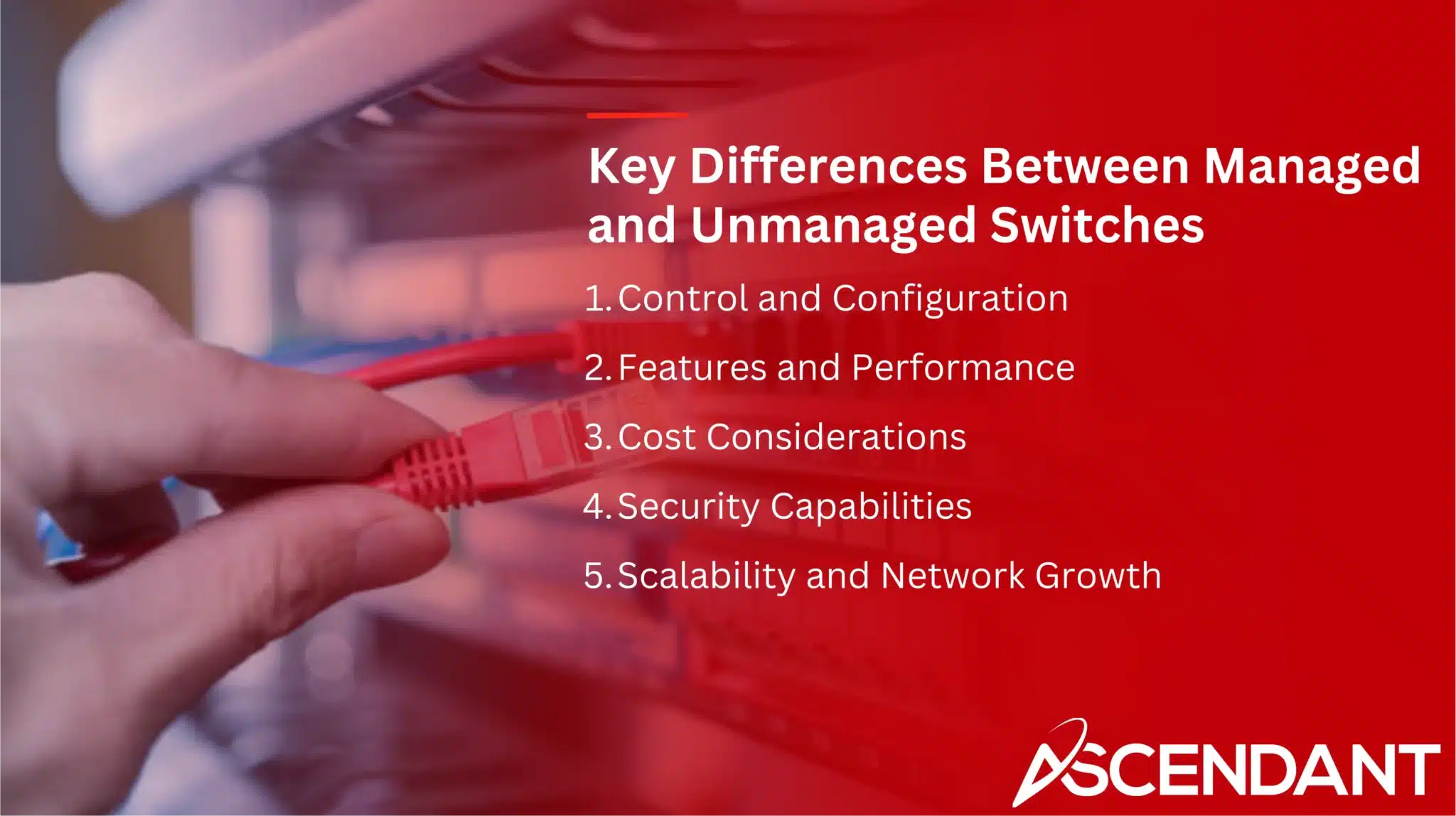Deciding between a managed vs unmanaged switch? Managed switches offer advanced features and control, while unmanaged switches are easy to use and set up. This article breaks down their differences to help you make the right choice for your network.
In This Article:
- Understanding Managed Switches
- What Are Unmanaged Switches?
- Key Differences Between Managed and Unmanaged Switches
- Locally Managed vs. Cloud-Managed Switches
- The Role of Smart Managed Switches
- Choosing the Right Switch for Your Network Needs
Key Takeaways
- Managed switches provide advanced features and configurability, making them ideal for larger and more complex networks requiring high performance and security.
- Unmanaged switches offer simplicity and affordability, suitable for smaller networks with minimal demands, but lack advanced security and management capabilities.
- Choosing the right switch depends on network size, complexity, and growth expectations, with smart managed switches serving as a middle ground for medium-sized businesses.
Understanding Managed Switches
Managed switches offer extensive options for tailoring and enhancing your network’s capabilities. These switches allow administrators to finely tune and oversee the settings of a network, guaranteeing optimal performance. Employing protocols like SNMP to monitor traffic flow and identify potential problems is vital in maintaining network health with these devices.
One significant advantage of managed switches is their support for VLANs, which organizes and improves both security and structure by segmenting traffic within the network. They also provide extra features such as port mirroring and Quality of Service (QoS) that elevate overall network efficacy by assigning priority levels to crucial data packets. In sectors where dependability and security are critical—such as corporate businesses or governmental entities—managed switches stand out as the preferred option.
For more intricate networks that need advanced management due to high volumes of activity or various operational requirements, managed switches fit perfectly, providing superior control over configurations. Network administrators who aspire to uphold strong, secure networking frameworks find these tools indispensable when they incorporate a managed switch into their setup.
What Are Unmanaged Switches?
Unmanaged switches are the embodiment of straightforwardness and user-friendliness within network setups. These devices, designed for immediate use, come pre-configured with static settings to facilitate a hassle-free setup without requiring manual adjustments. They efficiently manage connection specifics such as data rates and duplex arrangements on their own, making them suitable for rapid implementation.
Suited primarily for modest-sized networks, unmanaged switches provide elementary network connectivity without sophisticated functionalities. Their suitability extends to scenarios with limited networking needs like residential or small business environments. They might not perform optimally in more elaborate configurations due to the absence of VLAN capabilities and management interfaces even within simple network topologies.
Despite being advantageous because of their simplicity in certain situations, unmanaged switches do not offer the degree of control and security found in managed alternatives. This limitation becomes particularly relevant when dealing with networks that necessitate precise performance tuning alongside stringent security protocols.
Key Differences Between Managed and Unmanaged Switches
Managed switches and unmanaged switches differ primarily in their network control capabilities. Managed switches provide a range of features, improvements to performance, and security measures crucial for sizable or complex network infrastructures. Conversely, unmanaged switches are designed for straightforward tasks by providing simple connectivity without any options for configuration.
To determine the most appropriate switch type for your specific network needs, it’s vital to scrutinize these distinctions on various essential elements.
Control and Configuration
Managed switches provide network administrators with an unparalleled level of oversight and customization options for their networks. These switches allow admins to keep a close eye on and tailor the system, complete with remote access capabilities that enable them to manage issues promptly from any location, which is essential for maintaining superior network performance. Managed switches differ from unmanaged ones by allowing specific configuration adjustments, equipping them with advanced security features like access control lists (ACLs) and VLAN support that enhance the ability to restrict entry points and segment network traffic.
Conversely, unmanaged switches are designed without the possibility for modifications. They focus on simplicity through plug-and-play operation. They lack personalized settings or the capability to monitor traffic—this absence of adaptability may pose substantial drawbacks in contexts where sophisticated security protocols and granular management of the networking environment are imperative.
Features and Performance
The incorporation of advanced features within managed switches greatly boosts the efficiency of networks. Capabilities like VLANs, spanning tree protocol, and Quality of Service (QoS) facilitate the division and prioritization of network traffic, guaranteeing that vital data receives necessary bandwidth. This is especially important in business settings where network efficiency can directly affect productivity and the quality of services provided.
Managed switches provide thorough monitoring to detect and resolve congestion points, enhancing performance via controlled switch ports on managed switches. Having this degree of oversight and management is critical for sustaining an effective network, particularly in complex and evolving operational landscapes.
Cost Considerations
Managed switches provide advanced features, but at a steeper price. The initial outlay for managed switches is usually greater because of their complex capabilities and the technical know-how needed to run them. Ongoing costs can be substantial with managed switches since they typically necessitate consistent upkeep and administration.
Unmanaged switches are less costly and simpler to use. Their straightforward nature results in reduced upfront expenditures and low maintenance costs, which appeals to smaller networks operating on tight financial resources. Yet it’s important to balance these economic advantages against possible trade-offs regarding performance quality and security measures.
Security Capabilities
When selecting between managed and unmanaged switches, network security plays a crucial role. Managed switches provide substantial security features like 802.1X authentication and access control lists to safeguard against unauthorized entry, thereby boosting the overall security of the network. The ability to configure these settings ensures that managed switches can actively monitor and defend against diverse network threats.
In contrast, unmanaged switches do not have the functionality to apply these advanced security measures, rendering them more vulnerable. For enterprises dealing with sensitive information, it’s vital for their operations’ safety that they choose managed switches due to their superior protective capabilities—highlighting the significance of making an informed choice regarding switch type based on one’s specific requirements for data protection and control.
Scalability and Network Growth
Managed switches are designed to accommodate the intricate and expandable network structures necessary for bigger enterprises with evolving requirements. These switches excel in managing substantial numbers of users and a wide variety of tasks, which is crucial for environments that anticipate continuous growth and change.
Conversely, unmanaged switches suit smaller networks that have fixed needs and do not anticipate considerable expansion. Due to their confined functionalities, these types of switches can impede scalability, thus making them suboptimal choices for organizations intending to enhance their network infrastructure based on unmanaged switch technology.
Locally Managed vs. Cloud-Managed Switches
Opting for either locally managed or cloud-managed switches can have a considerable effect on how the network is configured and overseen. Switches that are managed locally necessitate hands-on access for their configuration, which might be restrictive in widely distributed setups. On the other hand, switches that are cloud-managed facilitate management through internet connectivity, granting the convenience to oversee and control networks from almost any location.
When it comes to simplifying management tasks, cloud-managed switches stand out by providing an easier way to configure settings via an online interface before they’re put into operation. This feature proves especially advantageous for organizations spread across various sites as it diminishes the necessity of physical upkeep and allows for centralized oversight of operations. These switches incorporate capabilities such as traffic shaping and Quality of Service (QoS), which help enhance network efficiency by guaranteeing vital applications have access to needed bandwidth.
Setting up cloud-managed switches tends to be quite user-friendly. Configurations can often be prepared prior to actual installation at a site. The combination of straightforward setup procedures with remote abilities to monitor changes in network performance renders these types of switches particularly appealing choices for expansive networks operating over multiple geographical areas.
The Role of Smart Managed Switches
Smart managed switches incorporate characteristics from both unmanaged and fully managed variants, positioning themselves as an intermediary option. Aimed at mid-sized enterprises, these switches deliver essential management features often through straightforward interfaces that simplify oversight for those with limited networking expertise.
While smart managed switches do not present the exhaustive configuration possibilities inherent to their fully managed counterparts, they provide a financially viable alternative for companies in pursuit of certain network control capabilities without bearing the full brunt of complexity or cost. This affordability paired with necessary functionality renders them an attractive choice for entities seeking a compromise between performance demands and financial constraints.
Merging the ease of unmanaged devices with elements of managerial authority found in managed solutions, smart managed switches grant organizations the flexibility to customize their network governance according to specific requirements. They facilitate achieving desired levels of efficiency and security while eschewing undue intricacy.
Choosing the Right Switch for Your Network Needs
Selecting an appropriate switch for your network requires assessing various elements such as network size, complexity, and particular requirements for performance and security. Unmanaged switches are often adequate for smaller networks with a limited number of devices, providing simple connectivity without the need for complex configuration settings. When a network expands in demand, it becomes necessary to look at managed switches.
For expansive networks that accommodate a substantial number of users, managed switches become essential by offering the required management capabilities and control needed to ensure peak operation efficiency and robust security measures. Smart managed switches can serve as an intermediary option suitable for mid-sized enterprises. These provide some degree of manageability while avoiding the full-fledged complexity and expense associated with fully-managed options.
The decision ultimately hinges on the distinct needs and potential growth trajectory anticipated from your network infrastructure. A thorough consideration of these aspects will assist you in identifying which type – unmanaged switch or smart/fully-managed one, aligns best with your specific networking conditions.
Summary
To sum up, selecting between managed and unmanaged switches depends on the particular requirements of your network. Managed switches provide a suite of advanced features, enhanced performance capabilities, and strong security measures suited for larger or more complex networks. Conversely, unmanaged switches are designed to deliver straightforward connectivity at an affordable price point for less complex or smaller-scale networks.
For those in search of a compromise solution, smart managed switches present an array of functionalities that fall somewhere between managed and unmanaged options. These come with fundamental management tools without significantly impacting cost-effectiveness. By grasping the principal distinctions and assessing what your network demands meticulously, you can choose wisely to secure both high-level functionality and protection for your network’s infrastructure.
 Frequently Asked Questions
Frequently Asked Questions
What are the main benefits of managed switches?
The primary benefits of managed switches include enhanced control over network configurations, support for advanced features such as VLANs and QoS, improved security, and the ability to manage networks remotely, which makes them particularly suitable for larger, complex environments.
Are unmanaged switches secure?
Unmanaged switches are generally less secure than managed switches due to their lack of advanced security features and configuration options. They are best suited for smaller networks with minimal security requirements.
How do smart managed switches differ from managed and unmanaged switches?
Smart managed switches differ from managed and unmanaged switches by offering a balance of management features and user-friendly interfaces, making them a cost-effective option for medium-sized businesses.
They provide more control than unmanaged switches while being less complex than fully managed switches.
What factors should I consider when choosing a network switch?
When choosing a network switch, prioritize your network’s size, complexity, performance, and security requirements.
Opt for unmanaged switches for smaller, simpler networks, and select managed switches for larger, more complex setups.
What are the advantages of cloud-managed switches?
Cloud-managed switches facilitate remote and centralized management, streamlining configuration and oversight of widespread networks.
Additionally, they enhance performance with features such as traffic prioritization and quality of service (QoS).


